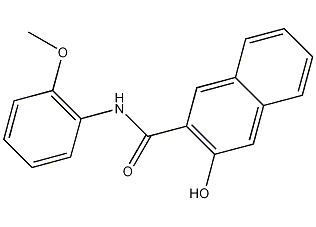
structural formula
| business number | 03qb |
|---|---|
| molecular formula | c18h15no3 |
| molecular weight | 293.32 |
| label |
naphto as-ol, naphthol as-ol, naphthol as-ol, naphthol as-ol, naphthol, naphthol as-ol, 2-(3-hydroxy-2-naphthamido)anisole, 2′-methoxy-2-hydroxy-3-naphthanilide, aromatic compounds |
numbering system
cas number:135-62-6
mdl number:mfcd00021630
einecs number:205-206-6
rtecs number:none
brn number:none
pubchem id:none
physical property data
none
toxicological data
none
ecological data
none
molecular structure data
molecular property data:
1、 molar refractive index87.23
2、 molar volume(m3/mol): 224.8
3、 isotonic specific volume(90.2k):622.4
4、 surface tension(3.0 dyne/cm):58.7
5、 polarizability0.5 10-24 cm3):34.58
compute chemical data
1. reference value for hydrophobic parameter calculation (xlogp): 4.2
2. number of hydrogen bond donors: 2
3. number of hydrogen bond acceptors: 3
4. number of rotatable chemical bonds: 3
5. number of tautomers: 9
6. topological molecule polar surface area 58.6
7. number of heavy atoms: 22
8. surface charge: 0
9. complexity: 387
10. number of isotope atoms: 0
11. determine the number of atomic stereocenters: 0
12. uncertain number of atomic stereocenters: 0
13. determine the number of chemical bond stereocenters: 0
14. number of uncertain chemical bond stereocenters: 0
15. number of covalent bond units: 1
properties and stability
this product is beige brown powder with a melting point of 167-168°c. insoluble in water, slightly soluble in sodium carbonate solution, soluble in ethanol, and yellow in sodium hydroxide solution.
storage method
none
synthesis method
the finished product is obtained by forming a salt from 2,3-acid and chlorobenzene; sodium carbonate; dehydration, condensation with anthranilate in the presence of phosphorus trioxide, neutralization with sodium carbonate, evaporation of chlorobenzene, and then filtration; drying. . raw material consumption (kg/t) 2,3-acid 710 anthranilate 470 phosphorus trichloride 270 sodium carbonate (98%) 570 chlorobenzene (98%) 150 insurance powder 8
purpose
it is mainly used as a primer for cotton fabric dyeing and printing. it can also be used to make fast pigments and as an intermediate for organic pigments.
tyle=”font-size: 9pt; font-family: arial; mso-fareast-font-family: arial; mso-font-kerning: 0pt”>10-24cm3): 34.58
compute chemical data
1. reference value for hydrophobic parameter calculation (xlogp): 4.2
2. number of hydrogen bond donors: 2
3. number of hydrogen bond acceptors: 3
4. number of rotatable chemical bonds: 3
5. number of tautomers: 9
6. topological molecule polar surface area 58.6
7. number of heavy atoms: 22
8. surface charge: 0
9. complexity: 387
10. number of isotope atoms: 0
11. determine the number of atomic stereocenters: 0
12. uncertain number of atomic stereocenters: 0
13. determine the number of chemical bond stereocenters: 0
14. number of uncertain chemical bond stereocenters: 0
15. number of covalent bond units: 1
properties and stability
this product is beige brown powder with a melting point of 167-168°c. insoluble in water, slightly soluble in sodium carbonate solution, soluble in ethanol, and yellow in sodium hydroxide solution.
storage method
none
synthesis method
the finished product is obtained by forming a salt from 2,3-acid and chlorobenzene; sodium carbonate; dehydration, condensation with anthranilate in the presence of phosphorus trioxide, neutralization with sodium carbonate, evaporation of chlorobenzene, and then filtration; drying. . raw material consumption (kg/t) 2,3-acid 710 anthranilate 470 phosphorus trichloride 270 sodium carbonate (98%) 570 chlorobenzene (98%) 150 insurance powder 8
purpose
it is mainly used as a primer for cotton fabric dyeing and printing. it can also be used to make fast pigments and as an intermediate for organic pigments.

 微信扫一扫打赏
微信扫一扫打赏

